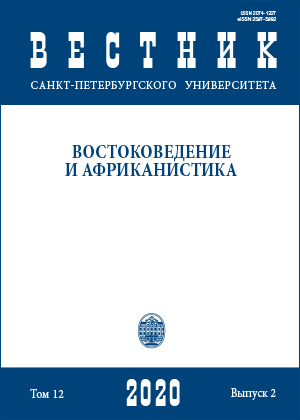Analysis of Semantics of Lexeme hava in Turkish
DOI:
https://doi.org/10.21638/spbu13.2020.203Abstract
The complexity of the analysis of the semantics of lexemes used to characterize environmental phenomena is due to the fact that they can combine naive and modern scientific meanings. The lexeme hava ‘weather’, ‘air’ was borrowed into Persian and Turkish from Arabic, however in the latter it does not have the meaning ‘weather’. In Persian and Turkish, hava is used to describe various phenomena in the environment (temperature, pressure, cloud cover, degree of illumination). This combines it with the ancient Turkic lexeme kün, which along with the more common meanings of ‘sun’ and ‘day’ was used to characterize weather phenomena. Hava is unrelated to the breathing process, is localized outdoors, and has historically been recognized as the localization of bird flight and uncontrolled upward movement of flightless objects (havaya uç-). The need to express modern scientific ideas and nomination of technical means determined the expansion of the compatibility of hava and the formation of the derivative verb havalan- ‘to take off’ (about aircraft). Turkish hava also has a number of figurative meanings. The meaning of hava, associated with musical works and instruments, could have been borrowed from Persian. The source of the figurative meaning of hava ‘appearance, behavior, style’ is most likely the French language, which in the 19th century was widespread among the intellectuals in the Ottoman Empire. The meaning of hava ‘void, empty’ is involved in a number of stable expressions and is not represented in either Arabic or Persian. Its source may have been naive ideas about the world structure, namely the part of it located between yer (‘earth’) and gök (‘sky’), in modern Western languages called prostranstvo, Raum, space etc., which have no direct equivalent in modern Turkish. “Materiality” as a characteristic feature of “naive space” in this case is expressed in the presence of a number of features available for sensory perception-the degree of illumination, temperature, clouds, pressure. This factor brings hava closer to the ancient kün in the above meaning.
Keywords:
Turkish language, naive model of the world, borrowings in Turkish, language nomination of weather phenomena
Downloads
References
Downloads
Published
How to Cite
Issue
Section
License
Articles of "Vestnik of Saint Petersburg University. Asian and African Studies" are open access distributed under the terms of the License Agreement with Saint Petersburg State University, which permits to the authors unrestricted distribution and self-archiving free of charge.





